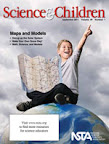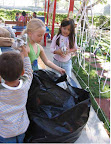Models, and maps, and spatial understanding
By Peggy Ashbrook
Posted on 2011-09-09
Teaching spatial awareness is part of most early childhood standards, such as the Head Start Child Development and Early Learning Framework (Understands directionality, order, and position of objects, such as up, down, in front, behind.), and it is part of national standards for K-12 curriculum such as the National Research Council’s A Framework for K-12 Science Education: Practices, Crosscutting Concepts, and Core Ideas . Joining in a traditional fingerplay teachs positional vocabulary:
Up and down, round and round (draw circles in the air),
Put your fingers on the ground.
Over (hold hands above lap) under, (below legs) in between (hide in between your legs)
Now my fingers can’t be seen!
Hands in front, hands behind , now my hands I cannot find.
Here’s my left hand , here’s my right,
Hands and fingers back in sight! (wriggle fingers).
How else can preK-grade 2 teachers prepare their students to understand their position in their room, their building, their community, their world, their “place in space”? There are many resources on teaching using representations—models and maps—available through the National Science Teachers Association elementary school journal, Science and Children.  The September 2011 issue has many “free” articles for teachers who want resources for teaching science but are not yet members. People who are members can send the link to colleagues to alert them to interesting articles such as the “Guest Editorial: Minds, Models, and Maps” by Kenneth Wesson who says, “The dynamic back-and-forth process of shifting images from the mind’s eye to paper and to tangible models is when children make their most creative and memorable connections.” He offers easy-to-implement strategies for incorporating illustrations, models, and maps. Another free article by NSTA 2001–2002 President and science education consultant Harold Pratt, describes the National Research Council’s new Framework for K-12 Science Education: Practices, Crosscutting Concepts, and Core Ideas in “Introducing A Framework for K–12 Science Education.”
The September 2011 issue has many “free” articles for teachers who want resources for teaching science but are not yet members. People who are members can send the link to colleagues to alert them to interesting articles such as the “Guest Editorial: Minds, Models, and Maps” by Kenneth Wesson who says, “The dynamic back-and-forth process of shifting images from the mind’s eye to paper and to tangible models is when children make their most creative and memorable connections.” He offers easy-to-implement strategies for incorporating illustrations, models, and maps. Another free article by NSTA 2001–2002 President and science education consultant Harold Pratt, describes the National Research Council’s new Framework for K-12 Science Education: Practices, Crosscutting Concepts, and Core Ideas in “Introducing A Framework for K–12 Science Education.” 
Children feel empowered and can see details when they make a really big model of a spider and her web. Join Marie Faust Evitt and her class as they hunt for spiders and make BIG connections in “A Web of Learning: Beyond “Itsy Bitsy Spider,” preschool students learn science content naturally”. And in The Early Years column I write about helping children build mental and visual maps of their area by taking walking fieldtrips and documenting their observations on a simple map. Even if your walking fieldtrip is just around the school building, children can look for traffic signs, interesting plants, and signs of animal life. This year the other teachers and I will take walking fieldtrips with the 3-year-olds too!
Peggy
Disclaimer: The views expressed in this blog post are those of the author(s) and do not necessarily reflect the official position of the National Science Teaching Association (NSTA).

